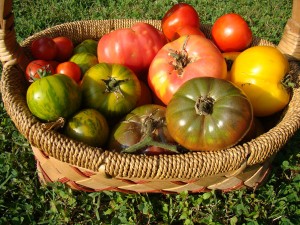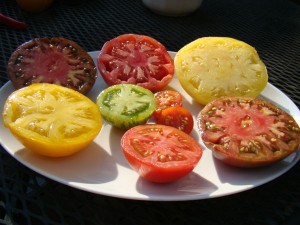Fri 21 Aug 2009
Keeping Up with the Tomatoes
Posted by Bob under Vegetable Garden
No Comments
It now seems amazing to me that that at the time of my last posting about our vegetable garden in mid-July, we were just getting a handful of Early Girl tomatoes. For weeks now tomatoes of many hues and varieties have poured forth from our garden, averaging 30-50 per day. (This on top of everything else mentioned earlier, with recent additions of carrots, eggplants, leeks, and melons).
Keeping up with this outpouring of tomatoes has been a challenge. We’ve been eating lots of gazpacho (there’s a nice simple recipe at Farmgirl Fare that not only dispenses with peeling and seeding, but with tomato juice as well), tomato sauce (click here for one favorite recipe, but follow the option for using fresh tomatoes) and salsa, salads (here’s a great recipe for black bean and tomato quinoa, although you can dispense with the complicated instructions for cooking quinoa and just cook it like rice, fluffing it up at the end), and of course tons of sliced tomatoes. But that’s made only a small dent, so we’ve been freezing tomatoes in various forms (but mainly just cored, bagged, and popped into the freezer) for uses in soups and stews in the winter. The fresh flavor holds amazingly well, even if the texture is mostly lost.
For my own memory and for fellow tomato growers (such as Donna, who posted a comment earlier on some of the varieties she is growing), I’m going to summarize and illustrate our experience over the past two years, when we began mainly to grow heirloom varieties rather than hybrids. (The distinction between these is variable, but in my view the key thing is that heirloom varieties are open pollinated while hybrids are not, with the further observation that the point of most hybridization has focused on appearance, ease of mass transport, and supermarket shelf life, rather than flavor.)
Last year at our patch at the community garden at Barclay Farms in Cherry Hill, New Jersey, we grew five heirlooms from seedlings started from seeds on our windowsills: Amish Paste, Brandywine, Dixie Golden Giant, German Pink, Paul Robeson, and Riesentraube, along with two hybrids: Ramapo (developed at Rutgers) and Beefy Boy. The hybrids turned out to be disappointing not only in taste but also in production, although the Dixie Golden Giant didn’t produce tomatoes until September (the whole tomato season was slow). We liked all the heirlooms, Monika ranking German Pink the best for taste (and me the Paul Robeson), with both of us appreciating the flavor and meaty consistency of the Amish Paste for sauces and roasting, as well as just plain eating.
This year the contingencies of having our house on the market ruled out filling the countertops and windowsills with seedlings, and it was only at the last minute that we knew for sure we would take possession of our Roseland home in mid-April. The newly-dug vegetable garden wasn’t able to be planted until mid-May, and we were unfamiliar with local sources of seedlings. So we ended up with a hodge-podge: Early Girl, Pink Girl and Lemon Boy (all hybrids) as well as heirlooms Black Russian, Cherokee Purple, Great White, and Green Zebra, along with two unidentified cherry tomato plants from our local friends Anke and Axel. As with our previous experience, the hybrids generally were not generally more productive or more resistant to pests or diseases, although there was some variation. Here is a more specific accounting (click on names for picture):
Black Russian: Rich, deep taste, highly productive with mostly dark-colored large tomatoes. Peaked in mid to late August. Highly recommended.
Cherokee Purple: Similar to Black Russian, but taste less rich and pronounced. Peaked in mid to late August. Black Russian probably a better choice for two rather similar heirlooms.
Early Girl: Three plants produced varying amounts of early (mid-July) fruit, but most production was in later August. Medium, red, quite hard hybrid tomatoes even when ripe. Comparatively tasteless. Will not grow again.
Great White: Mostly large (up to 2 pounds) light yellow (not really white) tomatoes. Sweet, pleasant tasting, but not overly distinctive. Very productive, though.
Green Zebra: Small to medium yellow/green tomatoes with very distinctive rich but tart flavor. Monika’s favorite. Highly productive, but insects seemed to zero in on this variety as fruits matured. Best to pick slightly unripe. Highly recommended; a wonderful contrast to other tomatoes.
Lemon Boy: Medium-large, orange-yellow hybrid tomatoes. Highly productive with most fruits perfectly formed and evenly-colored. Very attractive, but texture and taste rather mediocre. Heirloom Dixie Golden Giant last year was much more flavorful. Grew four plants this year; next year 1-2 should do.
Pink Girl: Medium to large pink hybrid tomatoes often with greenish tops. Quite productive, but fruits seemed particularly prone to blossom end rot. Pleasant fresh flavor, but certainly not up to last year’s standard of German Pink. Unlikely to grow again.
And last but not least, thanks to Anke and Axel for two highly-productive cherry tomato plants.
Note: While this year’s selection yielded a pleasant array of colors and tastes, what was missing was a good paste tomato. The tomatoes were good for eating fresh and for gazpacho, but less so for sauces and roasting. Need to plan better next time! We’ll almost certainly grow Amish Paste again.


No Responses to “ Keeping Up with the Tomatoes ”